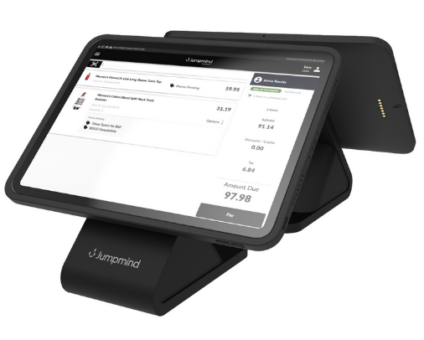Retailers are constantly looking for new ways to generate revenue and stay competitive. One strategy …
![]()
Cloud-native POS platform for seamless omnichannel customer experience.
![]()
A single hub for all promotions campaigns.
- Omnichannel ExperienceCreate seamless customer experiences
- Device IndependencePOS agnostic to form factor or operating system
- Self-CheckoutDo more with fewer associates
- Mobile StoreLeverage POS from anywhere
- POS on the GoEnable associates to sell outside of the store
- Unified PromotionsStreamline and simplify promotion workflows
- CX ConnectAllow customers to engage with POS during checkout
- Composable CommerceCreate the store experience you want
![]()
The most advanced synchronization solution for databases and file systems.
![]()
Data configuration and batch automation across different disparate systems and vendors.
-
Data Replication
- Multi-tier DistributionReplicate thousands of remote locations
- Cloud Database ReplicationCapture live changes from on-premise to the cloud
- High Availability and Load BalancingEnsure 24/7 access to data and scale efficiently with demand
- Analytics and ReportingCapture the whole picture with real-time reporting
- Multi-masterMaintain consistency of data in a peer to peer setup
- Data WarehouseReplicate live and historical data to a warehouse
- MigrationsConduct live data migration with no downtime
-
-
Data Integration
- Master Data ManagementChanges propagate across the entire system, allowing you to maintain a centralized view of all parts of your core business entities.
- Application IntegrationReduce dependencies, complexity, and risk to build a high-performance, data-driven application.
- Web ServicesIntegrate multiple systems using web services or build a business application using a service-oriented architecture.
- Data WarehouseIntegrate disparate data from multiple systems so you can transform data for better business intelligence and reporting.
- Data MigrationConduct live data migration during critical server replacements, storage upgrades, and data center relocations—with no downtime.
- ImplementationIntegration consultants help design, develop, and deploy an implementation of our products.
- DevelopmentThe product developers can add features, enhance existing functionality or build support for new platforms.
- TrainingEngage our experienced training resources to gain in-house knowledge and expertise on Jumpmind products.
- SupportLeverage product engineers to resolve issues, fix defects and provide updates or patches.
- Proof of ConceptDetermine the feasibility of implementing our products and get answers to your questions quickly.
Clienteling isn’t a new theory. It can be traced back hundreds of years when shopkeepers …
BOPIS, BORIS, and Curbside Pickup offer consumers and retailers the best of both worlds. …
View all Blog Posts
The SymmetricDS product can synchronize data between over forty different database platforms with out of …
Compare and Repair for SymmetricDS Pro can compare two databases, report on the differences, and …
Mobile replication with Android edge devices in near real time to an on-premise or cloud …
View all Blog Posts
Jumpmind President and CEO Joe Corbin to Lead Panel on Agility at Scale and Digitalizing …
Retail Technology Leader Jumpmind Brings Newfound Interactive and Personalized Digital Engagement to Inspire Shoppers at …
Retail Technology Leader Jumpmind Provides Enhanced Experiential Point of Sale and In-Store Engagement for Build-A-Bear Workshop …
View all Blog Posts
![]()
Cloud-native POS platform for seamless omnichannel customer experience.
![]()
A single hub for all promotions campaigns.
![]()
The most advanced synchronization solution for databases and file systems.
![]()
Data configuration and batch automation across different disparate systems and vendors.
-
Data Replication
-
-
Data Integration
-
Retail Retail trends, technology, and enhancing the customer experience
-
Data Thoughts on data matters, dialects, performance, and security
-
Case Studies How Jumpmind impacts the businesses of our clients
-
Videos & Webinars Watch on demand demos, reviews, and tours of our products
-
Company News Get the scoop on Jumpmind's growth and impact
View all Blog Posts
Replicate DB2 for IBM i with Journal-Based Change Capture

DB2 for IBM i journal replication captures only the changes as they occur on the database and sends them to all targets using the SymmetricDS tool. Journal-based change capture creates less impact on the source database while still achieving a reliable replication use case.
Popular Use Cases
- Cross Platform – Move data to a relational database such as Postgres, SQL Server, Oracle, MySQL and more.
- Data Warehouse – Setup a new data warehouse or data lake in the cloud.
- Analytics – Move data to one of the many cloud based platforms dedicated to analytics and reporting.
DB2 for IBM i Journal Setup
If you do not already have journaling setup for your application tables this will need to be done prior to replication. See the SymmetricDS documentation for details.
DB2 for IBM i SymmetricDS Documentation
DB2 for IBM i Journal Permissions
Grant USE authority to the journal and to all requested journal receivers.
Setup journal table images with the IMAGES(*BOTH) so that updates will contain old and new data. Without this changes to primary keys will not be replicated because the old ID is not provided in the journal and no update will be performed.
SymmetricDS Setup to Replicate DB2 for IBM i
In order to capture changes in DB2 for IBM i, setup a SymmetricDS node as a source with the following values. Changes will need to be made to provide your proper credentials such as hostname, database name, user, and password.

After connecting to the DB2 for IBM i database, provide the journal name that contains the changes as well as the library this journal is located.

Connect a target database after completing the connection setup for the DB2 for IBM i source database. Next, select tables for replication using the add table wizard. Finally, perform an initial load to send the existing data from the DB2 for IBM i to the target systems.
For more details on setting up the target node and tables to replicate watch this introductory video: Setting up your first sync scenario
Josh Hicks
Josh has worked in the IT industry for over 20 years as a developer, tech lead, and sales engineer. He has worked across a variety of businesses including retail, telecommunications, education, and healthcare. When he is not developing he enjoys whatever sporting event might be taking place.












